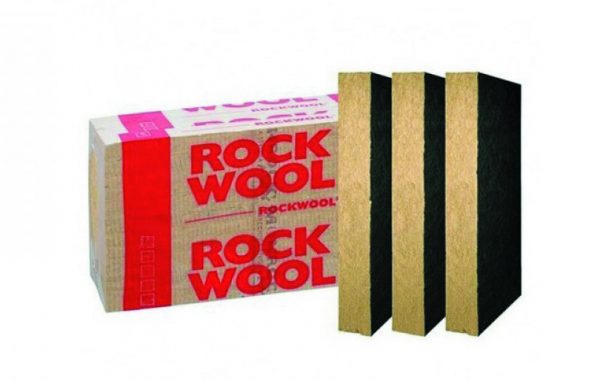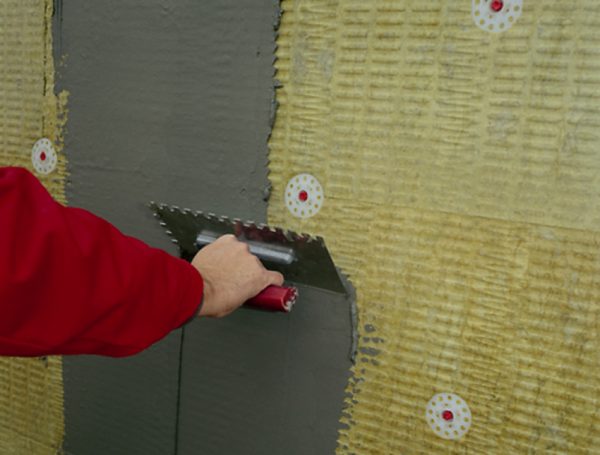For most homeowners, the task of reliable insulation of housing, coupled with giving it an aesthetic appearance, is very urgent. You can solve the problem in different ways, but the most effective and economical is the application of facade plaster.
- Types of facade insulation and features of their use
- Mineral wool plates
- Ecowool
- Glass wool
- Styrofoam
- Extruded Styrofoam
- Sprayed thermal insulation materials
- Calculation of the required thickness of the insulation
- Types of plaster for insulation
- Mineral Compounds
- Acrylic Blends
- Silicone plaster
- Silicate plasters
- Tools and materials for work - what else is needed?
- Ready plaster systems
- The technology of creating insulated facades
- Cleaning, priming the base and preparatory work
- Installation of insulation plates
- Reinforcement of insulation boards
- Final stage
- Application of decorative plaster
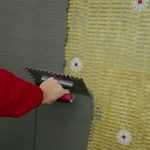
In addition to decorative finishes, thermal insulation is carried out by laying natural or artificial heat-saving materials. The facade insulation for plaster should be selected taking into account the type of building, cost, service life and a number of other factors.
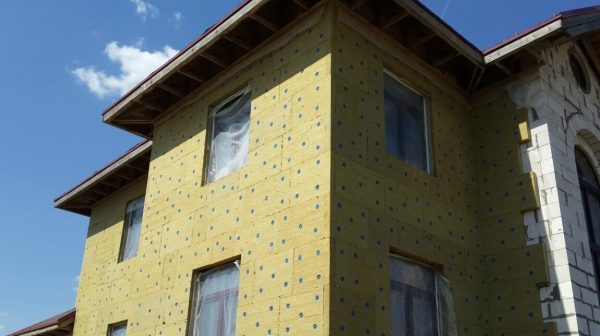
Types of facade insulation and features of their use
Facade insulation has obvious goals: increasing the comfort level for residents, optimizing indoor temperature and reducing heating costs. In fact, the use of thermal insulation solves another important issue. If the walls are cold, condensation inevitably appears on them, which gradually penetrates the thickness of the material, freezes, and then breaks it from the inside. Sooner or later, these walls will begin to collapse. If you increase the temperature on the surface and inside, condensation will not appear, therefore, the dew point will be output.
The essence of the use of insulation for plastering is to fasten any heat-insulating material to the wall of the house with its subsequent plastering. A special building mixture will protect the insulation from atmospheric and other negative factors, will create the basis for applying a decorative coating. On sale there are different types of insulation, each of which has its pros and cons.
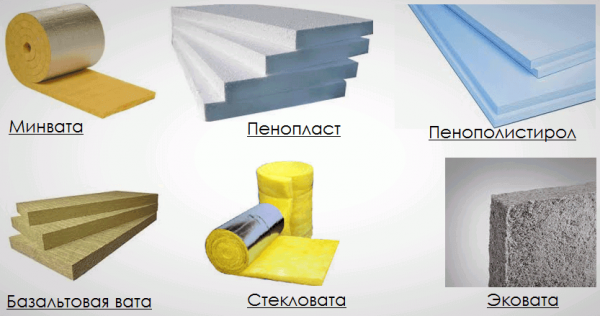
Mineral wool plates
The basis for the production of this insulation is basalt or other silicate rocks, as well as metallurgical slag. They melt, stretch into fibers with a large number of air channels. After the fibers are formed into plates with different densities and a certain number of layers.
The best mineral wool insulation for the walls of the house is a two-layer plate with a density of 100–125 kg / cubic meter. m, where the soft inner layer firmly adheres to the wall, adapts to its relief, and the hard outer layer is the basis for plaster. Plates (mats) of mineral wool have many advantages:
- strength and vapor permeability;
- excellent heat-saving properties;
- environmental friendliness, safety;
- lack of flammability.
to contents ↑The disadvantage of such a heater is significant - it is not able to withstand moisture, as a result, water literally saturates it, changing operational properties for the worse.The problem will have to be solved by soaking the cotton with water-repellent compounds. Also among the minuses is the heavy weight of the insulation and the ability to cause irritation on the skin.
Ecowool
This material is also called cellulose insulation, because it is made on the basis of cellulose. Its price is quite low, it gives excellent thermal insulation, breathable, environmentally friendly. However, ecowool for wall insulation is rarely used. It strongly absorbs moisture, as a result of which mold and fungus begin to multiply on its natural fibers. It is necessary to apply insulation on the walls using special equipment, which also reduces its popularity.
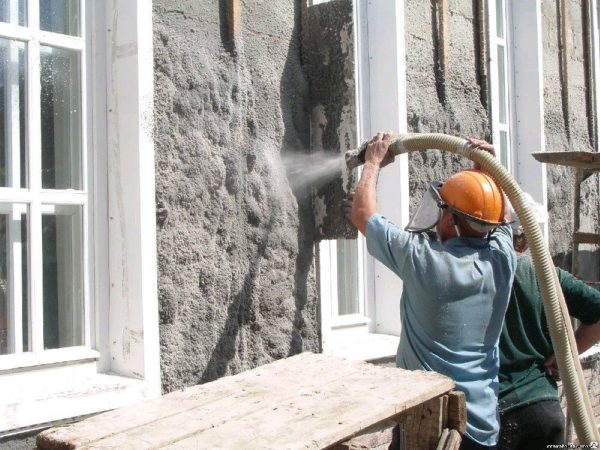
Glass wool
Glass wool is a well-known fibrous insulation for walls, which is a type of mineral wool. It is made on the basis of glass fiber obtained from waste from the glass industry. The insulation is characterized by high chemical resistance, increased elasticity, strength, vibration resistance. It has optimal thermal conductivity, which makes it possible to serve as a heat and sound insulating material.
Glass wool is available in plates and rolls. It can be used as a facade insulation for plaster, as well as for thermal insulation of internal partitions, roofs. Cons of the material:
- the need for the use of respirators, mittens during work (otherwise small fibers will harm health);
- crumbling and great shrinkage.
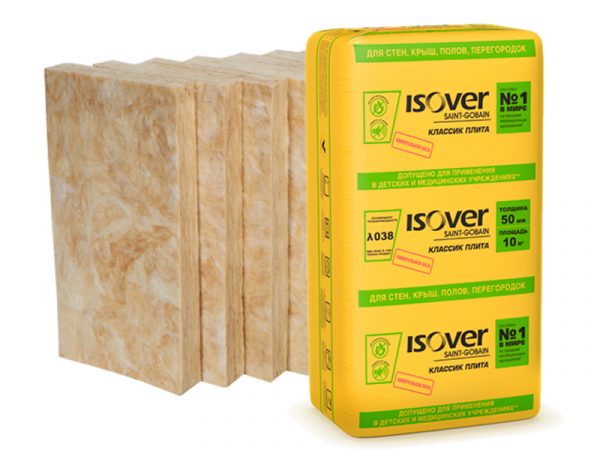
Styrofoam
Expanded polystyrene, or polystyrene, is a rigid polymer plate consisting of small granules filled with air. From above, the insulation is impregnated with flame retardants, therefore it does not support independent burning, but when smoldering from a different source it emits toxic fumes. The main advantage of the foam is its resistance to moisture and lightness, due to which the load on the foundation almost does not increase.
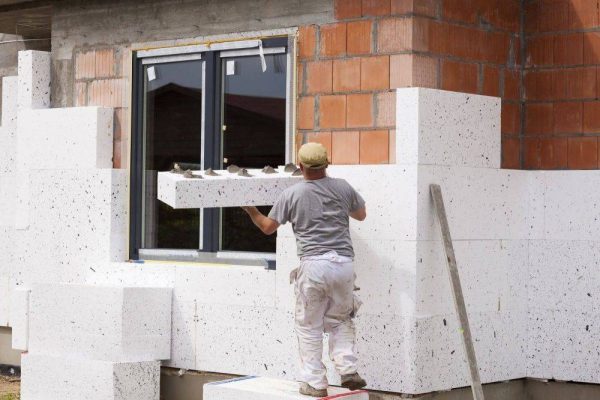
Polyfoam is a popular material for difficult climatic conditions. It does not lose properties during 80 cycles of freezing and thawing. This foamed insulation is ideally combined with plaster. By itself, he is afraid of ultraviolet radiation, collapsing under the rays of the sun, and rodents can also settle in it. After plastering, the material will fully show its operational characteristics, because it will be reliably protected from negative factors. The durability of such a combined insulation will increase, as well as resistance to weathering, the appearance of cracks, dents, scratches.
to contents ↑Extruded Styrofoam
This insulation is a type of conventional polystyrene foam with a more uniform finely porous structure. It has the best technical parameters, but it costs an order of magnitude more expensive. The advantages of the material over conventional foam are obvious:
- strength is ten times higher, therefore it can be used for facing socles and basement floors;
- the combustibility of expanded polystyrene is reduced;
- thermal conductivity of extruded plates is less than that of foam and mineral wool;
- thanks to the profiled edges, the installation of plates is easy, and there are no seams on the finished coating.
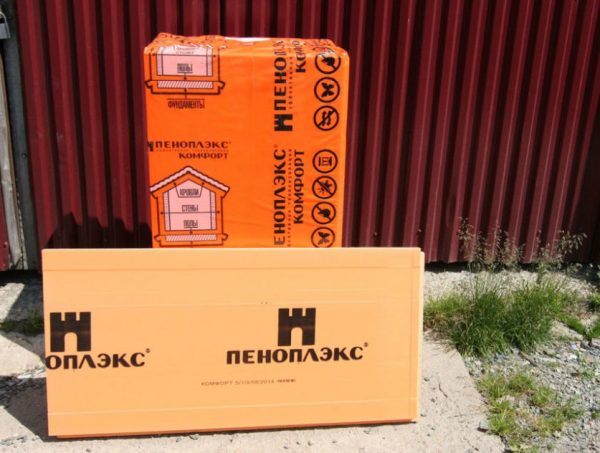
to contents ↑Extruded polystyrene foam does not allow vapor, gases, so the vapor permeability of the walls can be violated. The adhesion of the insulation with stucco mixtures is rather low, as a result of which its installation requires a special approach.
Sprayed thermal insulation materials
A separate group of heaters includes liquid sprayed materials. The most famous and popular among them is polyurethane foam in the form of foam, which is obtained by mixing the two main components. It is easy to apply such a heater, work is fast, and there are no seams left at all. It tightly adheres to all types of substrates: wood, brick, metal, concrete.
The sprayed heaters are very light, they tolerate humidity, temperature extremes, and exposure to chemicals. They must be protected from direct rays of the sun, because otherwise they begin to collapse from the action of ultraviolet radiation. In addition, the sprayed heater maintains the smoldering that occurs when in contact with an open flame.
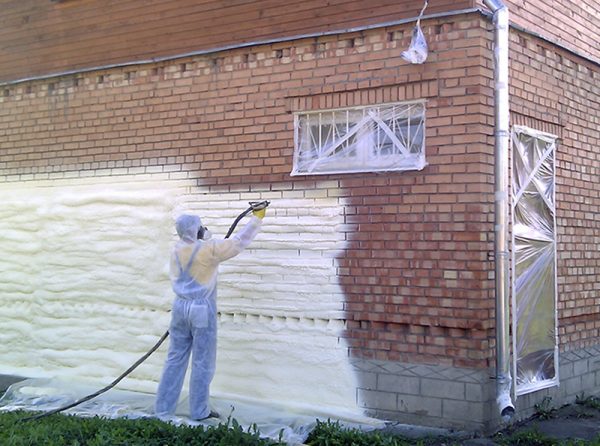
Insulation for facade plastering - we select the best option
When choosing a specific insulation for the house, you need to be guided by its durability, resistance to adverse factors, fire safety. Many take into account the availability of insulation at a price, availability in stores. However, these are not all the criteria that need to be considered. The shape of the insulation should be convenient for installation. It’s good if the material is hard enough and it can be fixed without much effort. The higher the insulating qualities of the insulation in plates or rolls, the better the result. It is important to know the bearing characteristics of the walls, so that the finished decoration does not spoil their properties.
Tips for choosing insulation for the exterior of the house are as follows:
- with low thermal conductivity of the walls (of wood, aerated concrete, cellular foam concrete), mineral wool boards or other vapor-permeable materials can be used;
- with high thermal conductivity of the walls (made of concrete, panels, slag concrete, brick), any insulation for plaster is suitable;
- the universal heat-insulating material is foam, which can be used in all cases, without the need for special equipment.
to contents ↑
Calculation of the required thickness of the insulation
When performing thermal insulation of the facade under the plaster, the latter is applied with a thin layer and has a minimal "warming" effect. In fact, it is needed to protect the insulation, extend its service life and improve the aesthetic characteristics of the building. The thickness of the plaster is not taken into account, but the thickness of the insulation boards is selected on the basis of special calculations.
It is not easy to calculate this indicator yourself. It is found in fairly complex formulas that take into account such information:
- type, thickness of the material of the bearing walls;
- heat transfer resistance;
- wall decoration material;
- average air temperature in winter;
- average humidity, wind strength;
- technical characteristics of a heater.
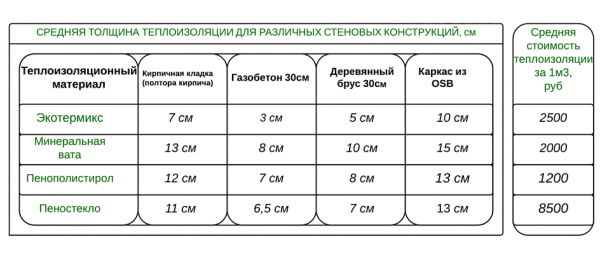
The specialist should make all the calculations, although in reality developers or owners rarely resort to such services. More often the experience of acquaintances, neighbors, the price of insulation is taken into service. Typically, the thickness of thermal insulation does not exceed 12–15 cm for polystyrene foam, 18–20 cm for mineral wool. In warm climatic zones, these indicators can be reduced by almost 2 times.
to contents ↑Types of plaster for insulation
Most often, the layer of plaster is 3-4 mm, but taking into account the glue and reinforcing fabric, the total thickness becomes somewhat larger. For plastering insulation, many types of mixtures are suitable, which can be applied in a thin layer. They are smooth and textured. The latter is enhanced by special fillers - mineral granules, cellulose fibers, stone chips.
Mineral Compounds
Mineral compositions for facade work are made on the basis of cement (gypsum, lime mixtures are not suitable for this purpose). Water-repellents, plasticizers are necessarily introduced into the composition, and microfiber fibers are often added to increase strength.
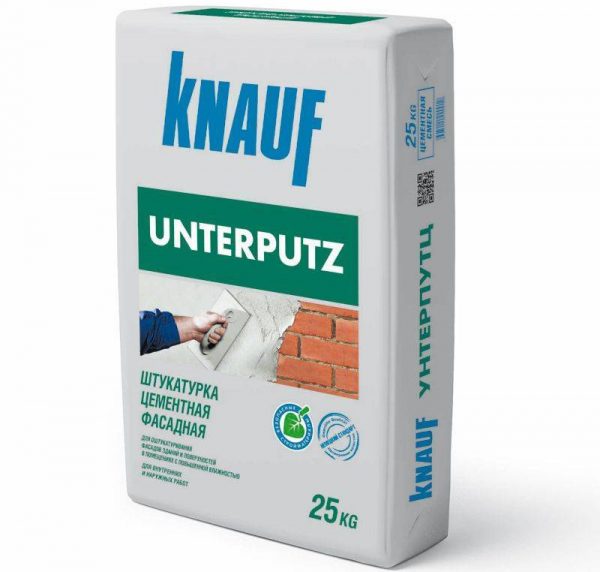
Mineral plaster is not bad for protecting insulation. It is affordable, environmentally friendly, vapor permeable, sold in a wide range. Nevertheless, it may be difficult to stain it, because most of the mixtures are grayish in color, and the main tone of the paint will necessarily change after application. You should not purchase mineral compounds without additional additives - their service life does not exceed 2-3 years, after which they gradually begin to crack.
to contents ↑Acrylic Blends
Acrylic plasters are made on the basis of acrylic resins. They are much more expensive than mineral ones, but their price pays off with improved technical characteristics. The service life of the compounds is very long, they are easily applied due to their elasticity, and do not crack even when the building shrinks. The coating will be durable, resistant to scratches, moisture, the appearance of efflorescence.
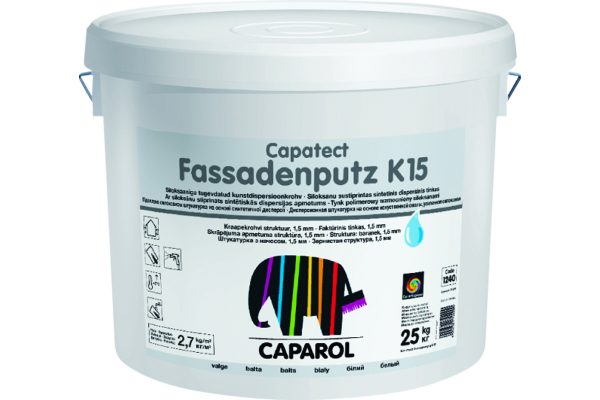
to contents ↑Acrylic mixtures are available in color variations and in white for tinting. They can be painted with any pigment, although under the influence of ultraviolet light, the color gradually fades. The coating has a slightly reduced vapor permeability and is not recommended for mineral wool. If desired, acrylic plasters can be applied as decorative, using various effects (fleece, bark beetle, rain).
Silicone plaster
Such plasters are implemented in finished form, they are distinguished by a large selection of colors. They practically do not burn out, as they are not afraid of ultraviolet radiation. The finished coating is durable, vapor-permeable and water-repellent, besides it is capable of self-cleaning, dust and dirt practically do not stick to it. The only disadvantage of silicone compounds is their high price.
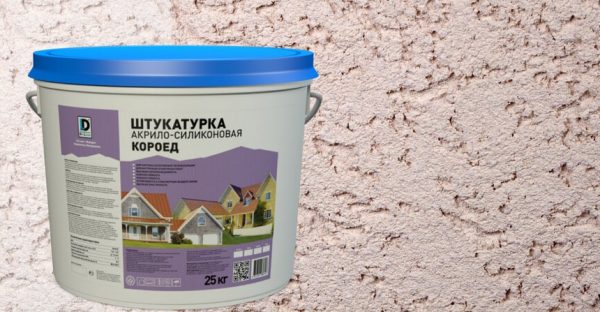
Silicate plasters
Materials under this name are made on the basis of polysilicon liquid glass. They are expensive, but they have maximum strength, vapor permeability, resistance to chemical, mechanical, biological damage. The color scheme of silicate compositions is pastel, but the colors do not fade with time. The material is quite elastic, so it does not crack even with strong shrinkage, vibration of the walls. Applying such plaster requires a certain level of skill, and for beginners the process may seem difficult.
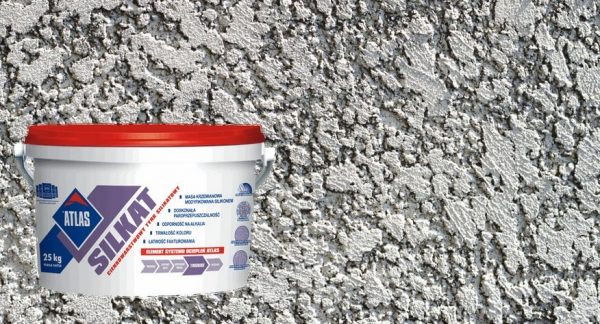
Tools and materials for work - what else is needed?
In addition to insulation boards and plasters for their coating, for the high-quality installation of the thermal insulation system, it is necessary to prepare a number of other devices and materials:
- adhesive composition;
- dish-shaped dowels - for additional fixing of a heater;
- reinforcing mesh and putty mixture - to strengthen the wall, ensure the strength of the finish;
- primer and primer - to enhance adhesion and hardening of the base;
- facade paint - for coloring plaster, if it has not previously been tinted;
- facade varnish - to protect pigmented and decorative plasters;
- aluminum basement profile and basement dowels for its fastening - for mounting the support of the 1st row of insulation;
- docking elements - for joining the ends of the basement profile;
- plastic expansion joints - for leveling walls;
- self-adhesive profile - to improve the adjacency of the reinforcing layer to door blocks, window frames;
- corner profile with mesh - to protect external corners from mechanical damage.
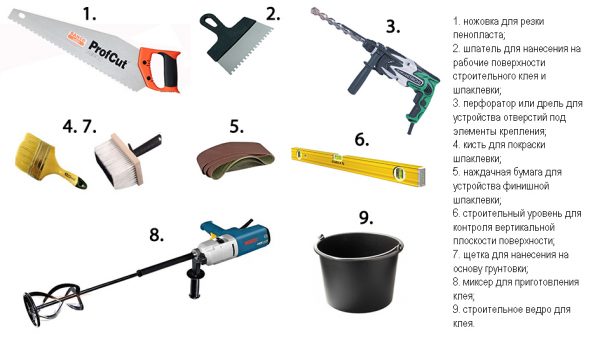
Ready plaster systems
Often in the construction stores implemented the so-called plaster system. These are sets that include glue, primer, insulation, plaster and paint, as well as other necessary materials. Usually they are issued by one company or are ideally matched to each other according to technical parameters. The most famous plaster systems are:
- Rockwool It includes several types of systems based on basalt wool with a thin or thick layer of plaster, as well as clinker tiles.
- Senerji PPS. Ideal for low-rise buildings, it includes expanded polystyrene insulation, adhesives, primers, decorative and protective plaster.
- Ceresit. Plaster complex based on extruded polystyrene foam.
- Caparol. Plaster system with polystyrene foam of different thicknesses.
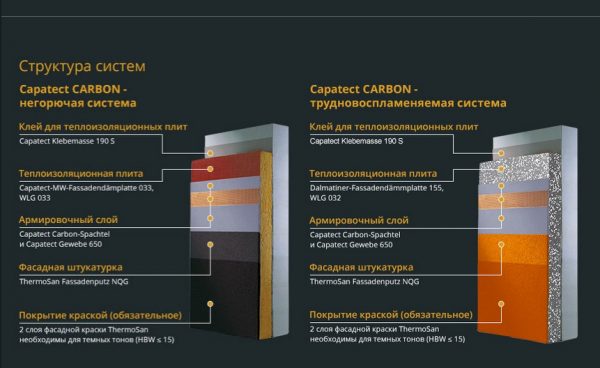
to contents ↑The cost of the plaster system depends on the manufacturer (domestic or foreign), the type of insulation, the type of plaster and the thickness of its layer.The so-called “warm plasters” for facades, in which vermiculite or perlite is additionally added, are more expensive.
The technology of creating insulated facades
In order for the thermal insulation of the house to work fully and serve for many years, all stages of its installation must be carried out strictly in accordance with the instructions.
Cleaning, priming the base and preparatory work
Thermal insulation of the facade is carried out only after completion of all internal finishing work, especially draft. Before the fastening of the insulation inside, a fine finish (paint, wallpaper, tile) must also be performed. Next, perform the following steps:
- The roof of the building, window and doorways are covered, hang brackets for attachments (if it is intended to be used).
- Walls are measured with a plumb line or level, all significant differences (more than 1-2 cm) are revealed.
- The surface in the area of defects is leveled with rough plaster, the protrusions are cut, ground.
- The walls are treated with a primer to strengthen the base, bond dust and enhance adhesion to the adhesive.
- A basement profile is fastened to the walls, which will serve as guides for the 1st row of insulation, and also protect the lower ends from adverse external influences.
The base profile is mounted along the horizontal starting line, specified by level. Typically, its height from the ground is 60–65 cm. The profile is attached to the wall with dowels and plastic washers, taking into account the compensation of facade irregularities. The lengths of the profiles are interconnected by special docking elements.
to contents ↑Installation of insulation plates
Typically, adhesives for the installation of insulation are sold in dry form for ease of transportation. They are diluted with water immediately before use. Such compositions retain their properties for an hour, so it is not worth diluting them in large portions. The adhesive mass is intensively mixed with a mixer until a homogeneous consistency.
The finished glue is distributed on the reverse side of the insulation boards with a plaster blade, smeared with a thin layer around the perimeter. In the middle of each plate, 2 slides of glue are laid, which, after pressing, will be distributed independently. They apply the plate to the wall, the glue that has come out is immediately removed with a spatula. The next row is laid taking into account the displacement of vertical seams, controlling the position of the level.
A day after applying the adhesive, the insulation is additionally fixed with dowels. They are selected based on the type of base, the thickness of the insulation. Usually plate-shaped anchor dowels are well suited for this purpose. They are installed in five places for each plate: along the edges and in the center, drilling holes with a diameter of 8 mm directly through the insulation. The depth of the holes should be 1.5 cm greater than the length of the dowels. First, chopiki is inserted into the holes, then anchors, hammering them all the way.
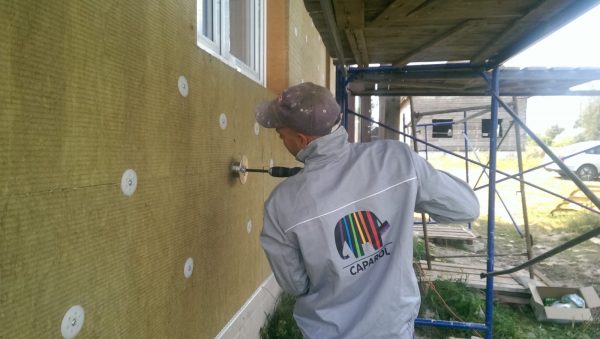
Reinforcement of insulation boards
After fixing the insulation, they begin to reinforce. Along the perimeter of all the openings are adjoining profiles - perforated lightweight metal strips with a plastic or fiberglass mesh. First, rectangles of about 20 x 30 cm are glued to the tops of all the corners in the openings, exposing them at 45 degrees with respect to the top point. For gluing use a special reinforcing putty, applying it with a thin layer and recessing the mesh. Top reinforcing material is lubricated with another layer of putty.
Similarly, reinforce corners with a grid along the protruding corners of the building, along the outer corners of windows and doors, which will help protect them from mechanical stress. A day after these manipulations, they begin to strengthen the remaining area of the walls, having previously bought a grid in rolls.For the finishing of the first floor, a reinforced mesh is acquired, for the rest of the surface the usual.
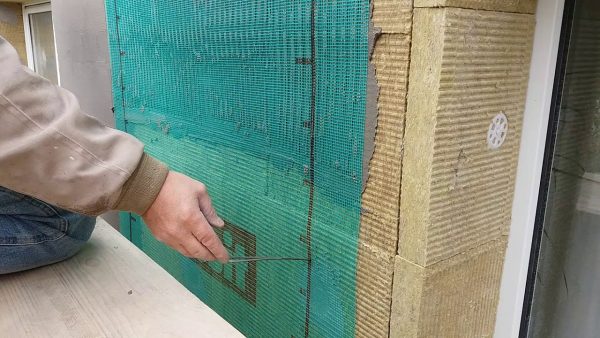
Installation of the reinforcing fabric is carried out using the same putty, applying it with a layer of 4 mm and leveling with a notched trowel. The canvases are laid with an overlap of 10 cm. The putty is smeared with a second layer with a layer of 2 mm already on the grid, smoothed with a smooth spatula until the flaws are removed. They make sure that no waves appear on the surface, and the glue layer is not too thick - it quickly crackes. By this principle, the entire area of the facade is reinforced by wrapping the canvas at the corners.
to contents ↑Final stage
After the glue has completely dried, the primer is primed with a special primer, which is applied with a roller or spray. Then, the plaster is distributed in one layer, leveled with the flat side of a metal or polyurethane spatula by performing circular movements. The dried layer of plaster is painted with facade paint, preferably on a silicone basis. Such paints give the most durable coating, not afraid of burnout, chemicals and abrasive effects.
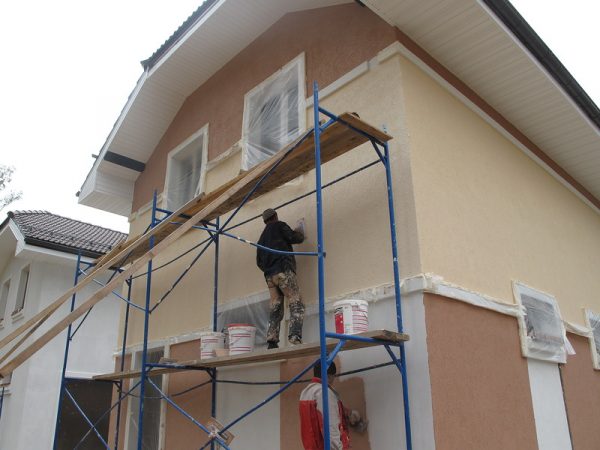
Application of decorative plaster
For the decoration of facades with laid insulation, decorative plasters are often used. It is the street materials that are selected that are highly resistant to temperature extremes and precipitation. The procedure will be as follows:
- start plastering at a temperature within + 5 ... + 25 degrees, humidity up to 70%, in calm weather;
- prepare the plaster mixture (diluted with water) or thoroughly mix the already prepared composition in a jar;
- gaining composition on a wide spatula, rubbing it on the wall with a thin layer (up to 4 mm); the specific thickness of the plaster is determined by the size of the filler fraction: the particles should be located in one layer;
- after drying, the plaster overwrites the base with a building grater until the desired texture is obtained;
- the finish is covered with paint or transparent varnish in 2 layers.
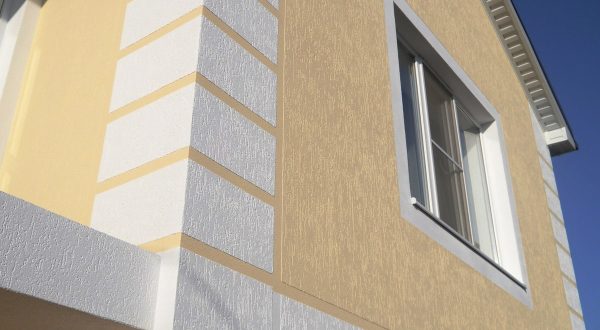
If you wish, you can stick insulation and plaster the house yourself. This work is painstaking, long, but not technically difficult, so even a novice master can do it.

